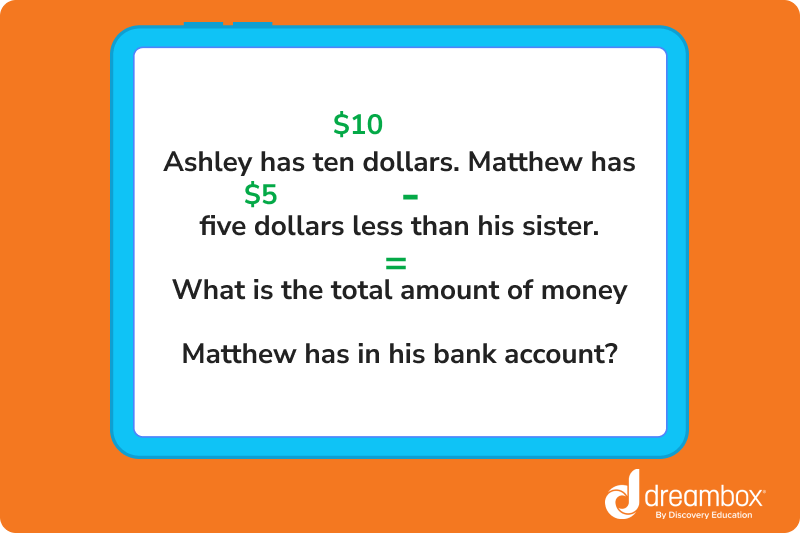How do you solve word problems in math?
Master word problems with eight simple steps from a math tutor!

Author
Amber Watkins
Published:
Oct 2024
Key takeaways
- • Students who struggle with reading, tend to struggle with understanding and solving word problems. So the best way to solve word problems in math is to become a better reader!
- • Mastery of word problems relies on your child’s knowledge of keywords for word problems in math and knowing what to do with them.
- • There are 8 simple steps each child can use to solve word problems- let’s go over these together.
As a tutor who has seen countless math worksheets in almost every grade – I’ll tell you this: every child is going to encounter word problems in math. The key to mastery lies in how you solve them! So then, how do you solve word problems in math?
In this guide, I’ll share eight steps to solving word problems in math.
How to solve word problems in math in 8 steps
Step 1: Read the word problem aloud
For a child to understand a word problem, it needs to be read with accuracy and fluency! That is why, when I tutor children with word problems, I always emphasize the importance of reading properly.
Mastering step 1 looks like this:
- Allow your child to read the word problem aloud to you.
- Don’t let your child skip over or mispronounce any words.
- If necessary, model how to read the word problem, then allow your child to read it again. Only after the word problem is read accurately, should you move on to step 2.
Table of contents
Access more math practice with DreamBox
Turn math into playtime with DreamBox Math
DREAMBOX MATH
Get started for FREE today!

Step 2: Highlight the keywords in the word problem
The keywords for word problems in math indicate what math action should be taken. Teach your child to highlight or underline the keywords in every word problem.
Here are some of the most common keywords in math word problems:
- Subtraction words– less than, minus, take away
- Addition words– more than, altogether, plus, perimeter
- Multiplication words– Each, per person, per item, times, area
- Division words– divided by, into
- Total words– in all, total, altogether
Let’s practice. Read the following word problem with your child and help them highlight or underline the main keyword, then decide which math action should be taken.
Michael has ten baseball cards. James has four baseball cards less than Michael. How many total baseball cards does James have?
The words “less than” are the keywords and they tell us to use subtraction.
Step 3: Make math symbols above keywords to decode the word problem
As I help students with word problems, I write math symbols and numbers above the keywords. This helps them to understand what the word problem is asking.
Let’s practice. Observe what I write over the keywords in the following word problem and think about how you would create a math sentence using them:

Step 4: Create a math sentence to represent the word problem
Using the previous example, let’s write a math sentence. Looking at the math symbols and numbers written above the word problem, our math sentence should be: 10 – 5 = 5!
Each time you practice a word problem with your child, highlight keywords and write the math symbols above them. Then have your child create a math sentence to solve.
Step 5: Draw a picture to help illustrate the word problem
Pictures can be very helpful for problems that are more difficult to understand. They also are extremely helpful when the word problem involves calculating time, comparing fractions, or measurements.
Step 6: Always show your work
Help your child get into the habit of always showing their work. As a tutor, I’ve found many reasons why having students show their work is helpful:
- By showing their work, they are writing the math steps repeatedly, which aids in memory
- If they make any mistakes they can track where they happened
- Their teacher can assess how much they understand by reviewing their work
- They can participate in class discussions about their work
Step 7: When solving word problems, make sure there is always a word in your answer!
If the word problem asks: How many peaches did Lisa buy? Your child’s answer should be: Lisa bought 10 peaches.
If the word problem asks: How far did Kyle run? Your child’s answer should be: Kyle ran 20 miles.
So how do you solve a word problem in math?
Together we reviewed the eight simple steps to solve word problems. These steps included identifying keywords for word problems in math, drawing pictures, and learning to explain our answers.
Is your child ready to put these new skills to the test? Check out the best math app for some fun math word problem practice.

The math program that drives results
Get started today!
DreamBox adapts to your child’s level and learning needs, ensuring they are appropriately challenged and get confidence-building wins.
Take at home math practice to the next level
Empowering parents and educators to make math practice more impactful. Plus, your kids will love it.


About the Author
Amber Watkins
Hello, my name is Miss Amber. I am an Education Specialist with a degree in Early Childhood Education. I have over 12 years of experience teaching and tutoring elementary through college level math. I also create both video and written math content that has helped educate thousands of students online. Knowing that my work in math education makes such an impact leaves me with an indescribable feeling of pride and joy!

